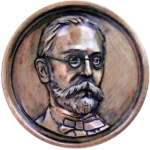W opracowaniu
Aktualny numer
Numery specjalne
Archiwum
O czasopiśmie
Redakcja
Rada Redakcyjna
Recenzenci
Instrukcja redakcyjna
Zasady etyki publikacyjnej
Zasady recenzowania
Ghostwriting
Prawa autorskie i polityka Open Access
Klauzula informacyjna RODO – dla autorów artykułów zgłoszonych do publikacji w kwartalniku „Komunikaty Mazursko-Warmińskie”
Kontakt
Cennik
PROJEKTY
Þœt is mid Estum Þeaw Þœt Þœr sceal œlces geðeodes man
beon forbœrned. Co właściwie powiedział Wulfstan o paleniu zmarłych
przez Estów we fragmencie swojego sprawozdania z podróży do Truso?
1
Muzeum Zamkowe w Malborku
Data publikacji online: 15-12-2015
Data publikacji: 15-12-2015
KMW 2015;290(4):557-578
SŁOWA KLUCZOWE
literatura staroangielskasprawozdanie Wulfstana z podróży do Witlandui Trusowydania i tłumaczenia raportu Wulfstanazwyczaj palenia zmarłychźródła archeologiczne
DZIEDZINY
STRESZCZENIE
In 1961 a part of Old English Orosius, the description of northernmost and central Europe, was
translated into Polish and edited by Gerard Labuda. The source contains two short travel accounts by Othere
and Wulfstan in the end of ninth century. The Polish editor did not avoid a number of linguistic mistakes
made during the translation. Moreover, this was issued without any syntactic and grammatical analysis of the
original Old English text. The Labuda’s edition only provides the Polish translation of the modern English
translation by the mid-nineteenth century English scholar Joseph Bosworth. This resulted in the wrong interpretation of some important information contained in it.
The subject of this paper is a one of the sentences included in the final fragment of the description of
the funeral rites among the Ests/the Old Prussians – „Þæt is mid Estum þeaw þæt þær sceal ælces geðeodes
man beon forbærned”.
My aim is to understand this passage of the OE text correctly by providing it’s linguistic and grammatical examination to see how it corresponds with the known or presumed historical circumstances of the time
and place. The interpretation of the old written source cannot be separated from its context, it this particular
case especially from the local archaeological context. This will be arguing in my paper.
At last,the above mentioned passage should be translated as:„And that is a custom among the Ests that
people of every nationality must be cremated there”. According to this custom, the dead body of every man,
that has passed away in the Witland, must be burned on the funeral pile. This Wulfstan’s description seems to
be strongly supported by the number of rich equipped graves of the foreigners discovered and archaeologically investigated at the number of early medieval cemeteries located in modern day city of Elbląg area and
dated to the VIII/IX/X/XI century.
Przetwarzamy dane osobowe zbierane podczas odwiedzania serwisu. Realizacja funkcji pozyskiwania informacji o użytkownikach i ich zachowaniu odbywa się poprzez dobrowolnie wprowadzone w formularzach informacje oraz zapisywanie w urządzeniach końcowych plików cookies (tzw. ciasteczka). Dane, w tym pliki cookies, wykorzystywane są w celu realizacji usług, zapewnienia wygodnego korzystania ze strony oraz w celu monitorowania ruchu zgodnie z Polityką prywatności. Dane są także zbierane i przetwarzane przez narzędzie Google Analytics (więcej).
Możesz zmienić ustawienia cookies w swojej przeglądarce. Ograniczenie stosowania plików cookies w konfiguracji przeglądarki może wpłynąć na niektóre funkcjonalności dostępne na stronie.
Możesz zmienić ustawienia cookies w swojej przeglądarce. Ograniczenie stosowania plików cookies w konfiguracji przeglądarki może wpłynąć na niektóre funkcjonalności dostępne na stronie.




